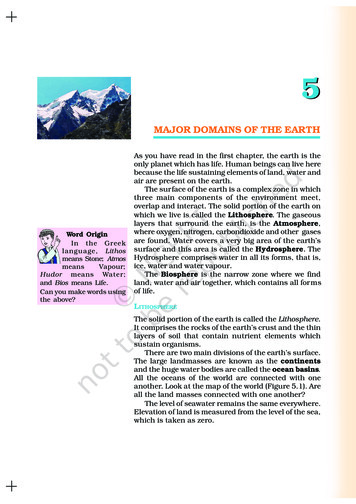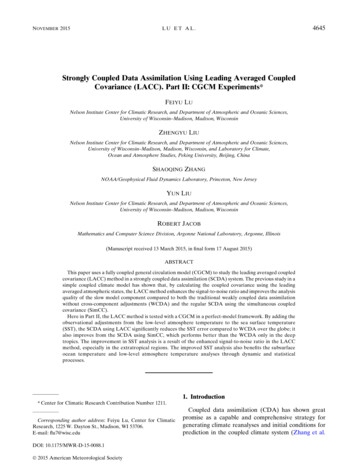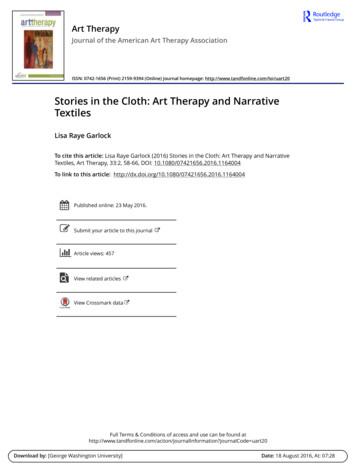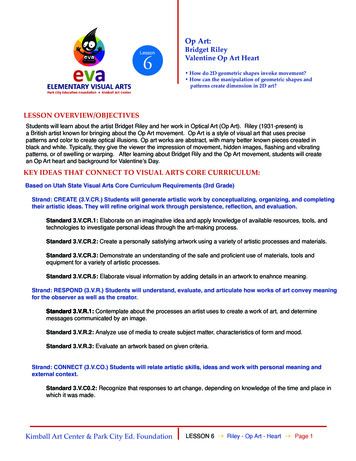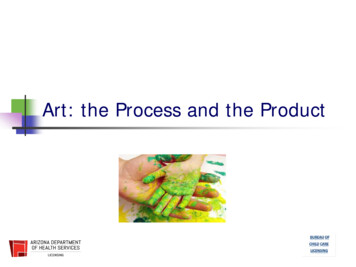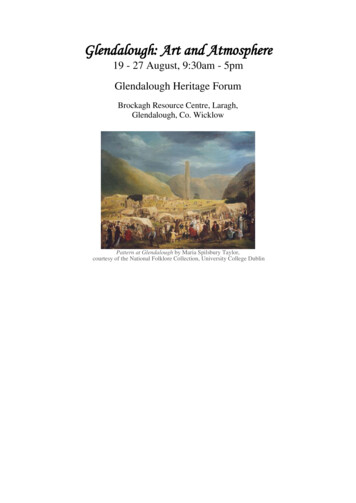
Transcription
Glendalough: Art and Atmosphere19 - 27 August, 9:30am - 5pmGlendalough Heritage ForumBrockagh Resource Centre, Laragh,Glendalough, Co. WicklowPattern at Glendalough by Maria Spilsbury Taylor,courtesy of the National Folklore Collection, University College Dublin
Table of ContentsArtists’ biographies .2Extracts from books .11Glendalough: Art and AtmosphereFollowing the success of last year’s exhibition by the Glendalough Heritage Forum of historic imagesfrom the National Library of Ireland’s collection of Lawrence and Valentine photographs ofGlendalough, the Forum is again mounting an exhibition of images of the Valley.This year’s theme is based on paintings, sketches and drawings of Glendalough showing how artistsviewed this historic valley. The images on view are but a small selection of the many paintings andsketches which were made of this area and come, in the main, from the National Library of Ireland’sPrints and Drawings Collection. Three paintings: the Patron of Glendalough by Joseph Peacock is heldin the Ulster Museum, one image of The Pattern at Glendalough by Maria Spilsbury Taylor is from theNational Gallery of Ireland, while the second Spilsbury Taylor painting is courtesy of the NationalFolklore Collection in UCD. These images give a sense of Glendalough as viewed ‘through the artists’eye’, leaving a legacy of their artistic creations and the atmosphere in which they saw this venerableplace.Glendalough has had many phases in its history: its golden age of monasticism, the introduction ofreligious orders, the reformation, its decline and then it rising again, like the phoenix in the late 18 thcentury when it again became a place of pilgrimage. This time it was the gentry who were interested inexperiencing the picturesque landscape and romanticism of the ruined valley. Glendalough and theWicklow mountains became an important part of every tourist’s visit to Ireland. From as early as the1770s visitors were coming to Glendalough to view the antiquities and to explore the beauties of thevalley. It was seen as important that the ruins which had lain waste for centuries should be recorded forposterity and that the Glendalough of the latter half of the 18th century has been preserved is due in nosmall manner to the Huguenot artist Gabriel Beranger and the Italian painter and architect Angelo MariaBigari. They came in October 1779, stayed in Derrybawn House, the home of James Critchley anddespite bad weather produced many drawings which were collected in a volume and presented to theRoyal Irish Academy.Following this resurgent interest in antiquities people such as Edward Wakefield who visitedGlendalough in 1809, Sir Walter Scott in 1825, John Barrow in 1835, the German writer Kohl, Bartlettand O’Malley Irwin all came in the 1840s, as did Mr and Mrs Samuel Hall. Since then various illustratedguides have been written, each one giving a personal interpretation of what Glendalough held for thatparticular individual. These accounts have served Glendalough well over the years as they portrayedGlendalough as a mystical, romantic, picturesque landscape with something on offer for all comers.They were in effect performing the modern day equivalent of the marketing guru, depictingGlendalough as a place that must be seen and therefore enticing further visitors and writers to theWicklow Mountains.Many of the images on view in this exhibition were painted or sketched for inclusion in these guidesand were an opportunity for people who were unable to travel to view the locations being described.They were the virtual tours of their day! This booklet accompanying the exhibition gives briefbiographies of the artists, the source of which can be found at http://www.libraryireland.com/irishartistswhere the reader can access more detailed information. The exception is Paul Sandby whose biographycan be viewed in full in The Oxford Dictionary of Art and Artists. The second section relates to extractsfrom some books in which the images appeared. Extracts have been selected to give a flavour of thewriters’ impressions of Glendalough and with the assistance of the images must have given the readera very good sense of the beauties and antiquities of this special place. The art of the artists, along withthe words of the writers, created a lasting atmosphere which we can still enjoy today.
The ArtistsWilliam Henry Beauford, 1735-1819Born in 1735, little is known of the personal history of William Henry Beauford. In 1769 he was oneof the sixty-one competitors who sent in designs for the building of the Exchange on Cork Hill. He wasan ardent student of Irish antiquities and was one of the founders of the Antiquarian Society. Heillustrated several of the antiquarian works published in Dublin at the end of the eighteenth century. Heaccompanied Rev. Edward Ledwich, his friend in an antiquarian tour of southern counties in 1786, andthe following year toured Carlow and Wicklow. Many of the drawings of houses, old castles, churches,monasteries and ancient remains made by him in these and other tours were engraved by James Fordfor Ledwich's Antiquities of Ireland, published in 1790. In his old age he became an inmate of Simpson'sHospital, Great Britain Street, now Parnell Street where he died in 1819, aged 84.Angelo Maria Bigari, Landscape Painter, fl. 1772-1779A native of Bologna, Italy, Bigari probably came to Ireland as a scene-painter, as about 1772 he wasemployed by Thomas Ryder at the Smock Alley Theatre. In 1777 he was living in South King Street.In 1779 he accompanied Gabriel Beranger in his tour to Glendalough and Connaught, assisting in thework of making drawings of ancient buildings and antiquities at the request of William BurtonConyngham. Beranger has left a manuscript account in which he frequently mentions Bigari, whom hefound a useful colleague and a genial companion. At that time Bigari only spoke French and Italian.Samuel Frederick Brocas, Landscape Painter, c.1792-1847Samuel Frederick Brocas, second son of Henry Brocas Snr. and brother of William Brocas, was bornabout 1792. He was a successful student at the Dublin Society's School, obtaining medals for his workin 1801, 1802 and 1807. He practised in Dublin as a landscape painter, both in oil and water-colour. Hecontributed to the exhibitions in Dublin in 1804, 1809 and 1812, and exhibited landscapes at the RoyalHibernian Academy between 1828 and 1847. He was a member of the Society of Irish Artists whichheld its first exhibition in 1845. His painting View looking into Powerscourt Demesne, an oil picture isin private hands. The National Gallery of Ireland holds two water-colours by him; a View of Dublinfrom near the Four Courts, and a View of College Green and Trinity College, dated 1818. Two watercolours, The Post Office and Nelson's Pillar, and The Castle Chapel, are in the Victoria and AlbertMuseum; and The General Post Office, Dublin, is in the British Museum.William Brocas, Portrait and Figure Painter, 1794-1868William Brocas, third son of Henry Brocas Senr. and brother of Samuel FrederickBrocas, was born about 1794 in Dublin where he practised He was an exhibitor at theSociety of Artists in 1809 and 1812, and at the Royal Hibernian Academy in variousyears from 1828 to 1863. His contributions were chiefly portraits and figure subjects,with an occasional landscape. He was President of the Society of Irish Artists which heldits first exhibition at the Royal Irish Institution in College Street in 1843; was elected an Associate ofthe Royal Hibernian Academy in 1854, and a Member in 1860. Amongst his works are RodericO'Conor's Castle, and Sunday Morning, exhibited in the Royal Hibernian Academy in 1847. HisDeparture of Irish Emigrants, was in the Dublin Exhibition of 1865. In Warburton, Whitelaw andWalsh's History of Dublin, published in 1818, is a view by him of the New Post Office. The NationalGallery of Ireland possesses his View of Bray Head. His portraits include The Grand Duke Michael,Thomas McKenny, Lord Mayor, and Edward Bunting, 1811. He also did a number of etchings afterHogarth's engravings which were published in Dublin.William Henry Brooke, Portrait Painter and Draughtsman, 1772-1860A British artist, Brooke worked in a banker's office, but left to pursue a career as an artist. He maderapid progress and established himself as a portrait painter. He first appeared at the Royal Academy in1810, and continued to exhibit at intervals until 1826. Among his exhibited works were Murder of
Thomas a' Beckett, Tourists in the South of Ireland ascending the Galtee Mountains in 1823; a sketchof The Battle of Waterloo in 1826; a Portrait of Robert Owen, the Welsh social reformer in 1834, nowin the National Portrait Gallery. He exhibited in the Royal Hibernian Academy in 1827, 1828, 1829,1842 and 1846, and was elected an Associate in 1828. In 1812 Brooke undertook to make drawings forThe Satirist, a London monthly publication, to which he contributed for a year. He obtainedconsiderable employment as an illustrator of books, including vignettes for the edition of Moore's IrishMelodies published in 1822. Among other works illustrated by him are Legends of Killarney, WilliamCarleton's Traits and Stories of the Irish Peasantry, published in Dublin in 1834 and 1835. Hecontributed to Ryland's History of Waterford, 1824; Lismore Castle, Round Tower, Ardmore, andReginald's Tower, Waterford. Brooke died at Chichester, after a long illness, in 1860, aged 88.Thomas Creswick, Landscape Painter, 1811-1869Thomas Creswick was born in Yorkshire where he displayed a great talent for drawing atan early age. Though only seventeen he moved to London in 1828 and was successful inhaving two paintings exhibited that year in the Royal Academy. He continued to exhibitpaintings in the Academy for thirty years. In 1837 he visited Ireland and produced anumber of illustrations. In 1842 he was elected an associate of the Royal Academy. Hewas mainly employed, very successfully, as a designer of book illustrations and etcher.Jonathan Fisher, Landscape Painter, d. 1809Born in Dublin, he was originally a woolen-draper in the Liberties, He took to painting asa young man and was said to be have been self-taught. In 1763 he was awarded 10 guineasby the Dublin Society for a landscape. He was a regular contributor to the variousexhibitions down to 1801. In 1792 Fisher commenced the issue of a series of views ofscenery in Ireland at the price of half a guinea each. The whole series, comprising sixty plates, wasissued as a volume in 1796 as Scenery of Ireland illustrated in a series of prints of select Views, Castlesand Abbeys, drawn and engraved in Aquatint.Samuel Lover, Miniature Painter 1797-1868Samuel Lover was born in Dublin in 1797, the eldest son of S. Lover, a lottery-officekeeper and moneychanger. While he joined his father at the age of 13, Lover’s talentslay elsewhere; he had an extraordinary aptitude for music and drawing. Though his fathersternly objected to him pursuing anything but making money, at age 17 Samuel left,supporting himself by teaching drawing while at the same time studying painting. By1817 and 1819 he exhibited drawings in the Dublin Society and again in 1823. Heinitially confined himself to landscape and marine subjects but was encouraged to venture into miniaturepainting.Lover began to exhibit in the Royal Hibernian Academy in 1826, and between that year and 1835 hecontributed ninety-six landscapes, miniatures and drawings. He was elected an Associate in 1828, anda Member in 1829. In 1832 he sent to the Royal Academy a miniature portrait of Paganini, the violinist,and showed it in the following year in Dublin. Encouraged by his success Lover determined to try hisfortune in London, and left Ireland in 1834. In that year he had six works in the Academy, and hisminiatures were seen there regularly every year down to 1843 and again from 1851 to 1862.During his time in Dublin Lover had demonstrated his versatility as a musician, a composer, a writerand book-illustrator. In 1818 he sang his eulogy on Thomas Moore, at the banquet given in honour ofthe poet. He contributed some of his stories to the Dublin magazines, including the Dublin LiteraryGazette. He wrote a number of songs, such as Rory O'More and Widow Machree. In 1831 he publishedLegends and Stories of Ireland, illustrated by himself, which had an immediate success.
In London he established himself as a miniature painter and made good connections, and in the literaryand social world he became as popular as he had been in Dublin. He commenced novel writing in 1836,with his Rory O'More, which was followed in 1842 by his best novel, Handy Andy, illustrated byhimself. With the arrival of the camera demand for miniature portraits declined and with Lover's failingsight he embarked on a new career of Irish Evenings, of songs, recitations and stories. He went toAmerica in 1846 with his show where he was met with great success in the United States and Canada.In 1848 he returned to London and gave a new entertainment, Paddy's Postbag. He began to paint again,and from 1851 to 1862 had a number of landscape drawings in the Academy. His last exhibited workin London was The Kerry Post on St. Valentine's Day, which he also had in the Hibernian Academy in1863. His latter days were passed in failing health, and for the last four years of his life he lived inretirement in Jersey, where he died in 1868.Alfred Nicholson, Water-colour Painter, 1788-1833Son of the English artist Francis Nicholson, he was born at Whitby in 1788. In early life he was in theRoyal Navy, but after a few years' service left and commenced his career as an artist. He came to Irelandin 1813 and remained until about 1817, when he returned to England. In 1821 he made a sketching tourin Wales, and again visited Ireland. His works, generally of small size, are carefully and accuratelydrawn and elaborately finished. He died in London in 1833. A drawing of an Irish landscape by him isin the Victoria and Albert Museum.Joseph Peacock, Subject Painter, c.1783-1837Joseph Peacock practised in Dublin as a painter, from 1810. He painted subject pictures, made copiesfrom the old Dutch masters, and worked as a picture cleaner and restorer. He contributed to the variousexhibitions in Dublin from 1809 to 1821, his first exhibited works being A Stage-coach Scene and aPortrait of a Lion. In 1811 he showed his Palmerston Fair. In 1821 he painted The Installation of aKnight of St. Patrick in St. Patrick's Cathedral, 27th May, 1819. He was chosen one of the originalMembers of the Royal Hibernian Academy on its foundation in 1823 and was an exhibitor from 1826to 1835. In 1817 he sent a picture to the London Academy, The Patron, or Festival of St. Kevin at theSeven Churches, Glendalough which was again exhibited the next year at the British Institution and isnow held by the Ulster Museum. Among other pictures by him were Donnybrook Fair, a scene in atent, and a copy, bust only, of Reynolds' portrait of John Hely-Hutchinson which hangs in the Provost'sHouse, Dublin.Peacock described himself as a ‘familiar life and animal painter.’ His son, Joseph Peacock Jun., enteredthe Dublin Society's School in 1816, and painted landscapes, figures and portraits and was an exhibitorin the Royal Hibernian Academy down to 1835.George Petrie, Archaeologist, Antiquarian, Painter, Scholar,Musician, 1790-1866Born in Dublin in 1789 in Dublin, George Petrie was a distinguished archaeologist,antiquarian, scholar, painter, illustrator and musician. His father, James Petrie was aportrait painter, acquainted with many leaders of the 1798 Rebellion, including MichaelDwyer whom he painted. George followed his father’s profession and by age 19 hadbegun to make excursions through the country in search of the picturesque, and toexamine and take careful notes of antiquities.In 1817 he began to exhibit in Dublin; but his most profitable work was furnishing sketches forillustrated books relating to Ireland, such as Cromwell's Excursions, Brewer's Beauties, andFisher's Historical Guide. He became an associate of the Royal Hibernian Academy in 1826, was aconstant exhibitor and was elected a member in 1828, appointed librarian in 1830, and was subsequentlyPresident. He contributed articles on current literature, antiquities, and archaeology to the Dublin PennyJournal from its establishment in 1832.
From 1833 to 1846 he was connected with the Ordnance Survey, visiting all parts of Ireland in thecourse of his duties. In 1833 his essay on the Origin and Uses of the Round Towers of Ireland gained aprize of 50 from the Academy. Following the break-up of the Irish Ordnance Topographical Surveyhe reverted to painting. His great work on The Ecclesiastical Architecture of Ireland was published in1845. Petrie also devoted much attention to the study of ancient Irish art and Irish music. He died atRathmines, Dublin 1866, aged 77, and was buried in Mount Jerome Cemetery. His fine collection ofIrish antiquities was purchased from his family by the Government and deposited in the Royal IrishAcademy.Paul Sandby, Painter, Draughtsman and Printmaker, 1731-1809Paul Sandby was born in Nottingham in 1731 and like his older brother, Thomas beganhis career as a military draughtsman. Both brothers saw service in Scotland, Thomasduring the 1745–6 Jacobite rebellion, and Paul after it, when he worked on a survey ofthe Highlands as part of the government campaign to subdue the area.By 1752 Paul had returned to London, where he lived for a time with his brother. He also spent timewith him at Windsor, where Thomas was a member of the household of the Duke of Cumberland,Ranger of Windsor Great Park (the brothers produced many views of Windsor and its environs, and theRoyal Library at Windsor Castle has an outstanding Sandby collection). In his later work he often usedbody colour, sometimes painting in oils, and he was the first professional artist in England to publishaquatints in 1775. Gainsborough singled him out as the only contemporary English landscape artist whopainted ‘real views from nature’ instead of artificial picturesque compositions. Both brothers werefounder members of the Royal Academy in 1768.Thomas Pope-Stevens, Portrait and Landscape Painter, fl. 1765-1780Thomas Pope-Stevens was the son Thomas Pope and brother of Somerville, Justin and Alexander, allartists. He entered the Dublin Society's School in 1764, the same year as his brother Somerville. In 1765he sent three landscapes and three portraits to the exhibition in George's Lane. In 1766 he exhibited twolandscapes and two portraits, and in 1768 and 1769 he was also an exhibitor. He continued to sendpictures to the Exhibitions of 1771, 1775, 1777 and 1780. He had as many as fifteen portraits and twolandscapes in the Exhibition of 1777.Francis Wheatley, Portrait, Landscape and Figure Drawer, 17471801Francis Wheatley was born in 1747 in Covent Garden, London, the son of a mastertailor. He received early art training and was awarded prizes by the Society of Arts in1762, 1763 and 1769; in 1765, at the age of 18, he sent his first contribution to theSociety of ArtistsHis progress as an artist was rapid; he was elected a Fellow of the Society of Artists in 1771, and aDirector the following year, and he attained to a considerable practice. He was, however, extravagantwhich led him into debt, and in 1779 he was forced to leave London for Dublin to avoid his creditors.He brought with him the wife of the water-colour painter, Gresse, whom he passed off as his wife. Thediscovery of this deception, when uncovered, obliged him to leave Dublin.In Ireland he met with much success as a painter. One of his best and most important paintings was AView of College Green with the meeting of the Volunteers on the 4th November, 1779, to commemoratethe Birthday of King William. This was followed by the even more important, picture, The Irish Houseof Commons in 1780: Henry Grattan urging the claim of Irish Rights. In 1783 he sent from Dublin tothe exhibition of the Society of Artists in London a Review of the Irish Volunteers in the Phoenix Park.This is possibly the picture which was for many years in the National Portrait Gallery in London andwas transferred in 1898 to the Dublin Gallery.
Besides painting portraits, including that of Henry Grattan, MP, Wheatley also did drawings ofimportant country seats and places in various parts of Ireland, such as Enniskerry, Glenmalure andGlendalough. He also drew rustic scenes with figures of peasants, which were popular, and obtained aready sale. Wheatley left Ireland in 1784, having got into further debt and returned to London where hedied in 1801.Maria Spilsbury Taylor Painter and Genre Painter, 1777 - c.1823Born in London in 1777, Maria was the daughter of John Spilsbury, the engraver.She painted portraits and rural and domestic subjects, and also did a few originaletchings. She exhibited at the Royal Academy from 1792 to 1808, and at the BritishInstitution from 1806 to 1813. In 1809 She married John Taylor and came toIreland in 1813 where she did many pictures and drawings and was an exhibitor ofsmall portraits at the Hibernian Society in 1814 and 1815. In a notice of the formerexhibition, the Monthly Museum says: ‘Mrs. Taylor's pictures exhibit a taste anddelicacy of execution rarely to be met with.’ She also exhibited, in Hawkins Street, portraits and ruralsubjects, such as Gipsies at a Cottage Door, and Pattern at Glendalough, in 1816 which is now heldby the National Folklore Collection, University College Dublin; All Hallow's Eve in 1817, and TheCottage Door in 1819.Rev. Luttrell Wynne, Topographical Artist, 1739-1814Born in London, Wynne was educated at Eton and Oxford and became rector of St. Erme Parish inCornwall. He was often absent from his parish as he embarked on numerous sketching tours of theBritain and Ireland. While not a skilled draughtsman he was prolific and worked in watercolour, penand ink and graphite. Many of his sketches appeared in books including The Antiquities of Ireland byFrancis Grose, published in 1795. On his death in 1814 he was buried in Westminster Abbey.The Antiquities of Ireland by Francis GroseThe valley of Glendaloch, in which the Seven churchesare situated, is in the barony of Ballynacor It contains a greatertreasure of genuine ecclesiastical antiquities than is to be found in anyother part of Ireland, too numerous to detail in this place, but they have been minutely describedin the antiquities of Ireland by the writer of these pages. The Seven Churches are, the Abbey,the Cathedral, St. Kevin’s Kitchen, Temple na Skellig, Our Lady’s Church, Trinity Church,and the Ivy Church.The number of churches and their ornaments, and picturesque scenery ofthe glen, simply repaid the writer the many hours he employed in viewingand describing these venerable remains. The paintings from this book areby Angelo Maria Bigari and Rev. Luttrell Wynne.From: The Antiquities of Ireland by Francis Grose, S. Hooper, 1795, pp. 96-97.Scenery of Ireland by Jonathan FisherArriving at the entrance, the prospect before you is composed of anassemblage of magnificent mountains, with cultivated spots in the valleybeneath, through which the river, at the principal source of theAvonmore, pursues its course towards Arklow, where it empties itself in St. George’s Channel.
Crossing the river Brocka over a handsome stone bridge of singular construction, andadvancing about one mile through this romantic scene, you discover that part of the Glen whichcontains the Churches, etc.Here the eye is agreeably surprised with the Ruins of several antiquebuildings, standing in the middle of a flat and rather extensive vale,environed by lofty mountains, watered by two small but rapid rivers,and terminated on the west by two deep lakes, from whence it derivesthe name of Glendalough.Some of the buildings are nearly entire, and ornamented with circular belfries, in a tasteextremely simple but not inelegant, and expressive of very great antiquity; others partlystanding and partly fallen, with various trees growing out of the walls, form a picturesque effectin shading these precious reliques, whilst others are either wrapt up in masses of ivy, and otherever-greens, or mowed down by the all-levelling and unrelenting scythe of time. When to thesewe add one of those slender round Towers, which we often find erected near our most ancientEcclesiastical buildings, and which are in a great measure peculiar to the antiquities of thiskingdom, we may have a general though faint idea of the present appearance of the SevenChurches;The first, and indeed the most considerable building in this island is theCathedral of Peter and Paul, founded by St. Kevin, so long since(according to Ware) as the sixth century. Great part of the walls of theChurch, with a little vestry-room adjoining, are standing, but the roof istotally demolished. By some fragments still remaining, it appears, that thewindows of this, and not unlikely all the other Churches, were ornamented with curioussculptures on the impost mouldings.Having now explored these remains of antiquity, you approach the Lakes,the principal of which extends about one mile in length, between themountains of Kemyderry and Lugduff. The scenery of this spot isuncommonly grand, and finishes the extent of this glen by a magnificentpiece of water, bordered by majestic mountains. The paintings in the bookare by the author, Jonathan Fisher.From Scenery of Ireland by Jonathan Fisher, 1795, pp. 1-6.Excursions through Ireland by Thomas CromwellGlendaloch, or the Valley of the Two Lakes, is a spot of more than commoninterest to the lover of Irish antiquities. Anciently, Glendaloch was anespicopal see, and a tolerably populous city, until about 1214, when the seewas annexed to the diocese of Dublin; and the city memorable for itsreligious edifices, not only suffered by decay, but insensibly became a receptacle for out-laws androbbers.
St. Kevin’s Kitchen (its vulgar appellation) was undoubtedly one of the sevenchurches; and is still almost entire, having suffered alone in the ruin of its onlywindow.Kevin drew multitudes from towns and cities, from ease and affluence, from thecares and avocations of civil life, and from the comforts and joys of society, to bespectators of his pious acts, and sharers in his merits, and with him, to encounterevery severity of climate and condition where a city soon sprang up, and aseminary was founded, from whence were sent forth many saints and exemplarymen, whose sanctity and learning diffused around the western world that universallight of letters and religion, which, in those earlier ages, shone so resplendentthroughout this remote, and, at that time, tranquil isle, and indeed was, except by the emigration of hersons, almost confined to it. On 3rd of June, annually, numbers, of every age and sex flock to Glendaloch,and there celebrate the festival of the still highly venerated St. Kevin.Our Lady’s Church, the most westward of the seven and nearly opposite thecathedral, is now almost entirely in ruins; but, from the door-way and the fewremains pf the walls, it appears to have been built with more knowledge of theart than the other buildings.We must now bid adieu to the once illustrious seminary, which, in the languageof a late writer, ‘was the luminary of the western world, whence savage septs and roving barbariansderived the benefits of knowledge, and the blessings of religion.’ The romantic shapes of thesurrounding mountains, (many of which are covered with wood, and others which, though of surprisingheight, retain the liveliest verdure almost throughout the year) the winding form of the fertile valley,the lake of considerable extent, all increase our veneration. In a word, on viewing such a scene ‘toabstract the mind from all local emotion would be impossible if it were endeavoured, and would befoolish if it were possible. Whatever withdraws us from the power of our senses; whatever makes thepast, the distant, or the future predominate over the present, advances us in dignity of thinking beings.Far from us, and from our friends, be such frigid philosophy, as may conduct us indifferent an unmovedover any ground, which has been dignified by wisdom or by virtue. That man is little to be envied whosepiety will not grow warmer as he treads the ruins of Glendaloch.’ The drawings in this book are byGeorge Petrie.From Excursions through Ireland, Vol III by Thomas Cromwell, J. Dowling, London 1820, pp. 135, 136, 140,144.The Beauties of Ireland by JN BrewerSuch are the mountainous wilds amidst which, in deep solitude and awful quiet,is situated Glendalogh, celebrated in early ages of Christianity for thecomparative splendour of its religious piles, and for a city of considerablepopulation; now a melancholy waste, romantic in character, and rich in antiquities, but visited by few,except the curious traveller and pilgrim.The first architectural object which arrests attention is a building whose antient appellation is forgotten,and which is now known only by a name familiarly borrowed from the vestment which screens itsdecay; that of the Ivy Church. This ruin is situated to the south of the traveller’s progress, andnear the customary path. On the opposite side of the river, towards the south-east, are the remains ofa building called by Mr. Archdall and Dr. Ledwich, the Priory of St. Saviour, and a chapel, which hadbeen buried in obscurity for many ages, and was discovered only a few years back. At the distance of
about a furlong to the west of the Ivy Church, we reach the former market-place of the city; to the southof which are the cathedral; a round tower; St. Kevin’s Kitchen; and other remains of ecclesiasticalbuildings. Nearby in the middle of the glen are the ruins of the abbey.The two
having two paintings exhibited that year in the Royal Academy. He continued to exhibit paintings in the Academy for thirty years. In 1837 he visited Ireland and produced a number of illustrations. In 1842 he was elected an associate of the Royal Academy. He was mainly employed, very successfully, as a designer of book illustrations and etcher.



